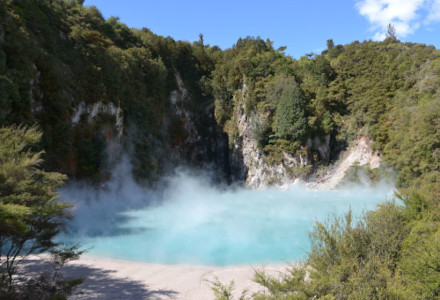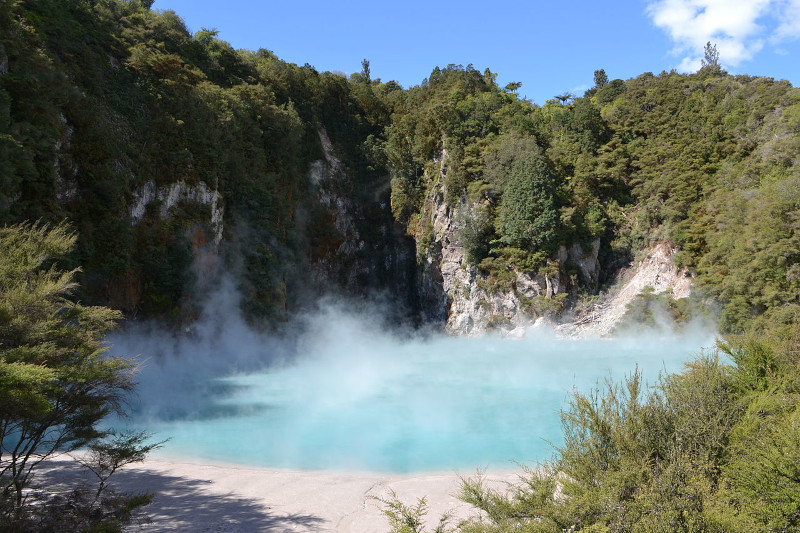Frying Pan Lake Facts
- This astounding geological formation most frequently goes by the descriptive, not to mention humorous, name of Frying Pan Lake. But it’s also often known by other, perhaps equally intriguing terms. Those, though, are typically only used by locals.
- Both of these terms, however appealing, represent older, no longer official names for the feature. That’s because the government of the surrounding region formally changed its name in 1963. Now, it’s known in official circles as the Waimangu Cauldron.
- In actuality, though, the new official name for the marvel’s rarely used outside of official circles. In practice, the vast majority of individuals still employ the older terms. Regardless of the name one uses for it, however, it’s a marvel of natural processes.
- It also represents just part of a much larger natural formation. That’s the site known as Echo Crater, itself further lying within the Waimangu Volcanic Rift Valley. The amazing hot spring also represents one of those select wonders that formed in recent times.
- This holds true since the breathtaking Frying Pan Lake formed due to natural processes in 1886. Despite its youth, though, it holds a place of distinction on any list of similar features. That’s due to the fact that it ranks as the largest of all known hot springs!
Related Articles
Frying Pan Lake Physical Description
One of the most impressive of the physical characteristics of the aptly-named Frying Pan Lake is its sheer size. That’s no surprise, however, given its ranking among other such sites. But the numbers involved still stagger the imagination, even knowing this information.
Its exact dimensions vary, of course, due to irregularities along its shore. It has a maximum measured diameter of a stunning 660 ft (200 m), however. It further boasts a phenomenal surface area as a result. This actually measures an astounding 409,029 sq ft (38,000 sq m)!
Despite this truly impressive statistic, though, the body of water remains quite shallow. In general, the remarkable hot spring has a depth of only around 18 ft (5.49 m). Around some of the vents, though, this plunges locally to depths measuring up to 66 ft (20 m).
This marvel of hydrothermal activity also has an extraordinary water volume, at least for a hot spring. That’s true since this equals roughly 7,063,000 cubic feet (200,000 cubic meters)! This fact clearly distinguishes it from other, similar features around the world.
This statistic, of course, brings us to its other attribute, its temperature. To the observer, the water appears to be boiling. This, however, is an illusion, created by escaping gases bubbling to the surface. The actual temperature of Frying Pan Lake averages 122-140 F (50-60 C).
Frying Pan Lake Location, Formation, and Nature
The tantalizing product of geological forces best known as Frying Pan lake formed in a part of the world already renowned for its great natural beauty. It’s also a section of the globe that qualifies as comparatively remote. This offers the hot spring a certain measure of protection.
More precisely, though, it formed in what now constitutes the island nation of New Zealand. This therefore places it in the southern portion of the Pacific Ocean. Its closest major neighboring land mass is the continent of Australia. It lies roughly 1,000 m (1,600 km) away.
The formation of this construction of Nature was a violent one, though. That’s due to the fact that it formed as a result of a volcanic explosion. This took place in 1886, when Mount Tarawera erutped. That action opened a series of craters along an 11 mi (17 km) rift.
Subsequent to that, however, the water came from rainwater and groundwater. Even then, though, it wasn’t yet as we see it today. A later eruption in Echo Crater, on April 1, 1917, began the process of filling the crater from hot springs, reaching its current size the next year.
The fabulous Frying Pan Lake also boasts yet another remarkable attribute. That’s the fact that it forms part of a unique cyclic hydrothemal system, along with a neighboring lake. Monitoring equipment indicates that the two levels and outlfow of the two have a rhythm.
More precisely, when the level and temperature of the water in one of them increases, those of the other decrease. This also has a reasonably precise, regular pattern to it. This process repeats itself, for reasons not fully understood, at fairly consistent 38-day intervals.
Features Sharing Its Region
Check out our other articles on 4 Mesmerizing Mediterranean Insects, Earth’s Many Stunning Waterfalls, 3 Fabulous North American Felines, 6 Mysterious Natural Phenomena


